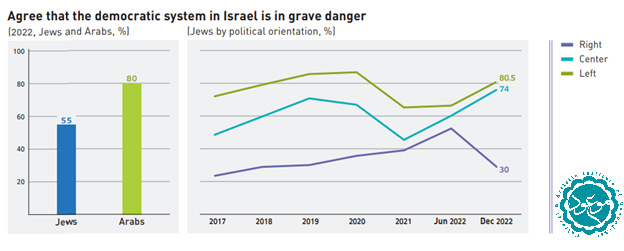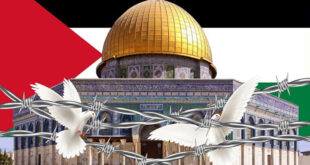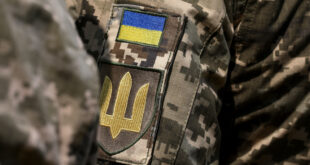According to Mouood, quoting by Shouba:
A review of 20 years of public opinion in the Zionist regime
The Israel Democracy Center (IDI) is an institution that has been continuously surveying the opinion polls of the residents of the occupied territories for more than 20 years, dividing them into Jewish, Arab, religious, secular, haredi, nationalist, etc. will pay. In the first week of 2023, this center has submitted a report to the president of the Zionist regime based on the annual routine.
This center has published a summary of the report on the attitude of the residents of the occupied territories in 2022, which it delivered to the current president of the Zionist regime, Isaac Herzog, on its website, which we will examine below:
20 years after the publication of the indicators of the Israel Democracy Center
Since 2003, the Democracy Center, under the management of Professor Tamar Hermann, publishes an annual report with a specific breakdown and an almost identical method of measuring different issues. Due to the continuity and continuity of the path from a center with a type of segregation of the statistical population, at least the comparison of data in the last 20 years can lead us to acceptable and reliable results so that the Zionist society can be judged.
The Israel Democracy Center seeks to measure the level of belief in democracy, respect and acceptance towards governing institutions, trust in the media, etc.
How do you see the general situation in Israel?
One of the constant questions of the IDI Center is the attitude towards the general state of the regime and the answer is in the form of good and very good, average and bad and very bad. The chart below shows the changes in responses from 2003 to the final months of 2022.

No year has been worse for the Zionists in the last 20 years than 2003, in the middle of the second Palestinian intifada. Years that will not be repeated so simply. More than 60% considered the conditions bad and very bad and only 10% were satisfied with the conditions.
The feeling of satisfaction with Israel’s conditions on the part of its citizens is almost on the upward trend after 2007, except for the drop in 2016 and reaches about 55% by 2018 and 2019.
But since that year, with the beginning of the internal crisis, Corona and the escalation of tension in the coast and occupied borders, a significant downward trend has taken place, and now the level of good and very good satisfaction has reached 26%. And on the other hand, 30% chose bad and very bad options to describe the current conditions of the regime, and 42% chose average.
I am proud to be Israeli
One of the internal challenges of the Zionist regime is the formation of the “Israeli” identity and its precedence over other existing identities influenced by the mosaic and Zionist immigrant society.
The graph below shows that the level of pride in being Israeli and accepting an “Israeli” identity among Jews has not changed much in the last two decades and has remained constant at an average of 85%, but among Israeli Arabs the situation is completely different and it is in free fall. Is; However, in 2022, it has compensated part of the fall. One of the reasons may be the presence of a coalition of Arabs in the Bent-Lapid coalition cabinet for the first time. Something that will probably experience another fall in 2023 when the current hard-line cabinet takes office.

The level of trust in governing institutions
One of the questions of the Israel Democracy Center, which is followed by many reflections every year after its publication, is the measurement of trust in the government institutions of the Zionist regime.
Confidence in the army in the occupied territories is always one of the stunning statistics of all polls. First of all, it is the military nature of the current existence of the Zionist regime. In the second place, the importance of the army, being in the military and being the gatekeeper of the news in an official and structured way about the army has led to the formation of a good attitude and trust in the army.
In addition to this issue, decades of fighting between the Zionists and the Palestinians is another reason for the high trust in the army among the residents of the occupied territories. However, in 2022, trust in the army is lower than the average of the last 20 years.

In 2022, after the army, trust in the president of the Zionist regime with 62%, the Supreme Court with 42%, the police with 35%, the government with 24%, the media with 23%, the Knesset with 18% and then the parties with 8%. 5% are in the next positions.
The media and the Knesset are two institutions that have faced a serious drop in public trust compared to the twenty-year average. The Israel Democracy Center has clearly emphasized in its report that in all the components measured in the chart above, they have faced a decrease in trust compared to last year.
Is your safety and well-being ensured?
In the results of the Israel Democracy Center, it is clearly stated that the citizens of the regime have always believed that the political structure has been more successful in providing security than providing prosperity. The graph below shows the response to the level of security and welfare in the last 4 years. (blue for security, green for prosperity)
The decrease in satisfaction with the state of well-being in 2022 to 18% shows that the conditions of inflation, the war in Ukraine and Lapid’s inability to manage the situation have seriously bothered the Zionists, and the analysis that the economic component has a serious effect on Netanyahu’s return to power is not far from reality. .

On the other hand, only 48% were in favor of providing security, which is not an acceptable statistic for the Zionist regime.
Rightism, increasing and acceptable
One of the hot topics in the occupied territories is the increase in the number of supporters and followers of extreme right-wing or religious Zionism. Unlike the first decades of the fake regime’s formation, which was run by the leftists, in the last two decades, more right-wing and radical parties have taken power. In the recent elections, the increase in the seats of extremists and the entry of parties such as religious Zionism into the list of the top parties in the elections pointed out that the Israeli society is becoming more right-wing day by day. The results and comparison of the Israel Democracy Center confirm this issue.

According to the results, if in 2003, 50% considered themselves right-wing, now 62% consider themselves right-wing and only 11% consider themselves left-wing. Another important point is that as the average age decreases, the percentage of rightism increases, which shows that rightism in the occupied territories is at the beginning of its upward path.
Where is the main conflict and tension of the social divide?
One of the challenging issues of the Zionists in recent decades has been various conflicts within the Mosaic and immigrant communities; Conflicts including right and left, Arab and Jewish, religious and secular, poor and rich, and finally Ashkenazi and Mirzai.
The table below shows the choice of the residents of the occupied territories regarding which conflict was the most serious and intense.

The most popular choice since 2012 has been the conflict between Arabs and Jews. But the conflict between Israel’s right and left has had many ups and downs in different years. In some years, the share of the battle between the secular and the religious also deserves more serious consideration. In 2018, the secular religious conflict will reach 25% and it will be close to other conflicts such as Arabs and Jews with 30% and right-left conflict with 32%.
Another result that can be clearly extracted from the chart below is the marginalization of the conflict between Ashkenazis and Mirzais, that is, the conflict between European and non-European races in the occupied territories.
Is the separation of powers respected?
The recent demonstrations in the occupied territories were clearly about Netanyahu’s actions to try to change the powers of the Supreme Court as a pillar of the judiciary and Netanyahu’s acceptance or not of the Supreme Court’s ruling on the disqualification of Arie Darei, one of his cabinet ministers, due to his records of corruption and wealth. The case of conviction in the occupied territories was marginalised; Something that shows the concern of the independence of the power of other forces in front of the government.

In a question, to what extent is the separation of powers observed in the Zionist regime? The above graph shows that 46% chose too little, 31% chose appropriate and only 11% chose too much. What it proves is that the challenge of the power and authority of the Supreme Court is very controversial.
Is democracy in danger?
In 2022, 80 percent of Israeli Arabs considered democracy in Israel to be in serious danger, compared to 55 percent of Jews. These figures show the serious concern of the Zionist society about some discrimination in the Arab society and the continuous political instability in the structure. This figure is expected to increase due to the recent events after Netanyahu’s return to power and Netanyahu’s efforts to change the laws and powers of the Supreme Judicial Court.
But on the other hand, there is a serious difference between the concern about the state of democracy in the regime among the leftists compared to the Jewish rightists; In December 2022, 80% of leftists were worried about democracy, but due to the fall of Bennett’s cabinet and the election of Netanyahu, this concern has decreased to 30% among rightists.

Conclusion
A review of the published report shows that some concerns in the occupied territories, such as a decrease in trust in institutions, an identity crisis, or concerns about democracy, are completely justified. The Israel Democracy Center (IDI) in its summary says that the Israeli society is moving towards intensifying the differences in identity, attitudes and views of institutions, just like holding 5 elections in the last 4 years.
 Mouood Mouood English Edition
Mouood Mouood English Edition




